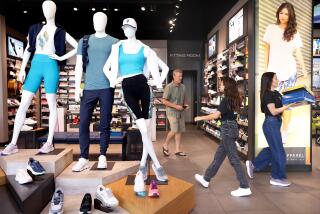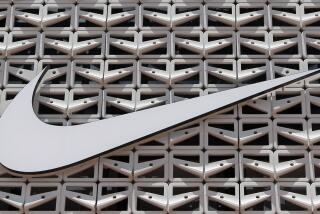Leaping Forward : Athletic shoes: K-Swiss Inc. in Pacoima has achieved rapid sales growth, but the recession may slow it down.
- Share via
While behemoths Nike Inc. and Reebok International Ltd. have been fighting for the top spot in the U.S. athletic-shoe market, little K-Swiss Inc. in Pacoima has quietly been enjoying sterling growth.
Under the guidance of President Steven Nichols, who took the helm in 1987 after leading an investment group’s buyout of K-Swiss for about $20 million, K-Swiss has posted the sales gains by carefully expanding its once stodgy product line and its marketing channels.
K-Swiss, which basically made one shoe--a leather tennis shoe called The Classic--for two decades before Nichols’ arrival, now sells a variety of shoes for tennis, boating, hiking and basketball. Most carry K-Swiss’ trademark five-stripe design along each side of the shoe.
It also has begun selling children’s shoes--no surprise there, since Nichols came to K-Swiss from an executive job at the children’s shoemaker Stride Rite Corp.--and has boosted its international presence.
As a result, the company’s sales last year jumped 41%, to $98 million, after sales had soared 72% the previous year. K-Swiss’ profit in 1990 totaled $7.2 million, up 52%.
That’s still small potatoes compared to Nike (fiscal 1991 worldwide sales of $3 billion) and Reebok ($2.2 billion in 1990), which together control 49% of the U.S. athletic-shoe market’s $6 billion in total annual sales, according to the trade newsletter Sporting Goods Intelligence in Glen Mills, Pa. Toss in third-ranked L. A. Gear Inc., and those three alone have 61% of the market.
Nonetheless, if K-Swiss maintains its rapid growth, it could soon become one of the 10 largest athletic-shoe companies in the nation. It ranked 12th as of Dec. 31 with 1.6% of the market, the newsletter says.
“I can’t predict what our growth will be,” said Nichols, 49. “But we haven’t begun to maximize our brand in the United States.”
But can K-Swiss keep up the sizzling pace? It’s a tall order, given the U.S. economic recession in general and flat consumer spending in particular. “The whole industry probably doesn’t have as much growth ahead of it as before,” said Dick Silverman, editor of Footwear News, a trade publication in New York.
After double-digit percentage sales growth in the late 1980s, “we’re looking at maybe a 3% to 5% growth rate for 1991 in dollar sales” for the whole industry, said John Horan, editor of Sporting Goods Intelligence.
So far this year, much of K-Swiss’ growth has come from its increasing international sales, and its foreign business might determine how much overall growth K-Swiss records. Last year, international sales accounted for 17% of K-Swiss’ business.
In the quarter ended June 30, for example, K-Swiss’ domestic sales fell 7% from a year earlier, but its foreign sales more than doubled, giving the company an overall sales gain of 15%, to $28 million.
Nichols said a delayed shipment from one supplier in the quarter contributed to the lower U.S. sales. But he was more guarded in discussing whether his company would again show domestic sales gains for the second half of the year.
Indeed, Nichols professes to pay little attention to how quickly K-Swiss grows, preferring to focus on K-Swiss’ self-proclaimed obsession with selling a quality shoe whose design lasts for years. “We really have no goal” for size, he said. “We just want to do it right every day, and the bigness will take care of itself.”
He does contend that sluggish U.S. retail spending actually benefits K-Swiss, whose shoes carry suggested retail prices ranging from about $30 to $75 a pair. “When times are difficult, and they are now in retail, we shine” because of the “perceived value” of K-Swiss’ footwear, Nichols asserted.
Some industry observers say the changing financial times also work in K-Swiss’ favor. Horan said certain sneaker makers--notably L. A. Gear, with its metallic laces and ever-changing designs--suited the “glitz and excess” of the free-spending 1980s.
But now, with consumers turning financially conservative in the 1990s, the marketing of K-Swiss’ shoes as classically designed and durable “is a very appealing story” to shoe buyers, Horan said.
If so, the trend hasn’t been a big plus yet for K-Swiss’ Class A shares, which were first sold to the public for $17.50 a share in June, 1990. Since then the stock has climbed as high as $30.25 and dropped as low as $10.50, and it closed Monday at $20 a share in national over-the-counter trading.
It’s likely that interest in the stock is muted by the fact that Nichols and the rest of K-Swiss management still have overwhelming control of the company. They own 86% of K-Swiss’ Class B shares, which each carry 10 votes versus the single vote accorded each Class A share.
Nichols, a tanned, bespectacled and soft-spoken man whose salary and bonuses last year totaled a handsome $736,000, said the stock setup enables K-Swiss to avoid worrying about satisfying Wall Street’s short-term goals and to plan for years ahead.
“The management isn’t involved in doing things that support the market price of K-Swiss, as opposed to supporting our brand,” he said.
That’s why Nichols doesn’t fret over K-Swiss’ profit margin, which was 7.3 cents per sales dollar last year, below the 8 to 10 cents that Nike and Reebok earned in spite of their huge advertising and overhead budgets.
“We’re still investing in people and systems” to further K-Swiss’ growth, he said. The investment includes a new, computerized, 250,000-square-foot distribution center in Fontana, where K-Swiss’ shoes--which are made mostly in Asia to K-Swiss’ specifications and using Argentine leather--are brought for sorting and packaging to customers.
“That’s the advantage of not having to produce a certain number,” Nichols said. “We can take a long-term look and decide what’s best.”
K-Swiss also has been investing heavily in its own advertising, which will total $7 million this year, 10 times the advertising budget Nichols inherited four years ago. Among the campaigns: using National Basketball Assn. players--including Maurice Cheeks of the New York Knicks--to promote K-Swiss’ new basketball shoes.
Isn’t that what all of the other sneaker makers do, get jocks to persuade kids that their shoes are best? Not quite, Nichols said.
“We prefer to sign only back-court men”--typically the shorter players in the guard position--”as opposed to some 7-foot guy because we don’t think it’s that easy for a young person to identify with them,” he said. “We also like to sign people who are articulate and can go out and talk and represent us in the community.”
In other words, K-Swiss tries to maintain its upscale image whether it’s vying for a sale to an inner-city kid playing blacktop basketball or to a young tennis player at the country club.
As Horan said, it’s all part of K-Swiss’ strategy of being “the Volvo of sneakers.”
More to Read
Inside the business of entertainment
The Wide Shot brings you news, analysis and insights on everything from streaming wars to production — and what it all means for the future.
You may occasionally receive promotional content from the Los Angeles Times.











